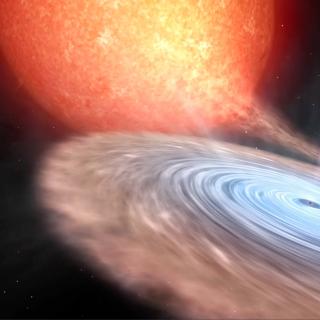Bibcode
Torres, M. A. P.; Casares, J.; Jiménez-Ibarra, F.; Muñoz-Darias, T.; Armas Padilla, M.; Jonker, P. G.; Heida, M.
Bibliographical reference
The Astrophysical Journal
Advertised on:
9
2019
Journal
Citations
97
Refereed citations
89
Description
We present time-resolved 10.4 m Gran Telescopio Canarias and 4.2 m William Herschel Telescope intermediate resolution spectroscopy of the X-ray transient MAXI J1820+070 (=ASASSN-18ey) obtained during its decline to the quiescent state. Cross-correlation of the 21 individual spectra against late-type templates reveals a sinusoidal velocity modulation with a period of 0.68549 ± 0.00001 day and semi-amplitude of 417.7 ± 3.9 km s−1. We derive a mass function f(M) = 5.18 ± 0.15 M ☉, dynamically confirming the black hole (BH) nature of the compact object. Our analysis of the stellar absorption features supports a K3-5 spectral classification for the donor star, which contributes ≈20% of the total flux at 5200─6800 Å. The photometric 0.703 ± 0.003 day periodicity observed during outburst is 2.6% longer than the orbital period supporting the presence of a superhump modulation in the outburst light curves. In line with this interpretation, we constrain the binary mass ratio to be q ≃ 0.12. In addition, we observe a sharp increase in the Hα emission line equivalent width during inferior conjunction of the donor star that we interpret as a grazing eclipse of the accretion disk and allows us to constrain the binary inclination to i ≳ 69°. On the other hand, the absence of X-ray eclipses during outburst imply i ≲ 77°. These inclination limits, together with our dynamical solution, lead to a BH mass in the range 7─8 M ☉. We also measure a systemic velocity γ = −21.6 ± 2.3 km s−1, which, combined with the Gaia second data release proper motion and parallax, implies a large peculiar velocity ∼100 km s−1.
Related projects

Black holes, neutron stars, white dwarfs and their local environment
Accreting black-holes and neutron stars in X-ray binaries provide an ideal laboratory for exploring the physics of compact objects, yielding not only confirmation of the existence of stellar mass black holes via dynamical mass measurements, but also the best opportunity for probing high-gravity environments and the physics of accretion; the most
Montserrat
Armas Padilla